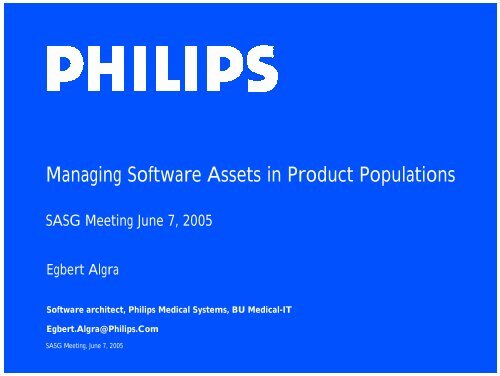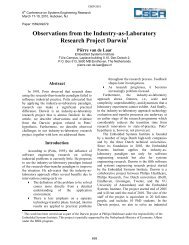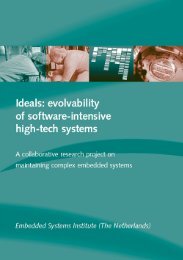SCM variant version management
SCM variant version management
SCM variant version management
Create successful ePaper yourself
Turn your PDF publications into a flip-book with our unique Google optimized e-Paper software.
Managing Software Assets in Product Populations<br />
SASG Meeting June 7, 2005<br />
Egbert Algra<br />
Software architect, Philips Medical Systems, BU Medical-IT<br />
Egbert.Algra@Philips.Com<br />
SASG Meeting, June 7, 2005
Overview<br />
• PMS introduction<br />
• Problem introduction<br />
• Approach<br />
– Things that work<br />
– Problems that remain<br />
• Conclusion<br />
Philips Medical Systems, Egbert Algra, SASG Meeting 07/06/2005<br />
2
Introduction: PMS company<br />
• Employees: 30.000<br />
• Development sites:<br />
– The Netherlands: Best and Heerlen<br />
– Finland: Helsinki<br />
– Germany: Hamburg and Böblingen<br />
– Israel : Haifa<br />
– USA: Bothell and Seattle, Washington; Reedsville and Philadelphia,<br />
Pennsylvania; Andover, Massachusetts; Milpitas and Oxnard, California;<br />
Cleveland, Ohio; Chicago, Illinois<br />
• Considerable growth<br />
– Doubled in size last 5 years<br />
– More organic and acquisition growth anticipated<br />
Philips Medical Systems, Egbert Algra, SASG Meeting 07/06/2005<br />
3
Introduction: PMS products<br />
• Medical Imaging equipment (“modalities”)<br />
– X-ray<br />
– Ultrasound<br />
– Magnetic resonance<br />
– Computed tomography<br />
– Nuclear medicine, PET,<br />
– Radiation oncology systems<br />
– Patient monitoring<br />
– Information <strong>management</strong> and resuscitation products.<br />
• Services (training and education, business consultancy,<br />
financial services and e-care business services)<br />
• Worldwide market share in Top-3 segments<br />
– (competing GE and Siemens)<br />
Philips Medical Systems, Egbert Algra, SASG Meeting 07/06/2005<br />
4
Product samples<br />
Philips Medical Systems, Egbert Algra, SASG Meeting 07/06/2005<br />
5
Product trends<br />
• Combined products<br />
– Combined products (CT/PET, MR/Xray)<br />
–HW and SW<br />
• Including the ‘SW only’ parts<br />
• Similarity towards the end-user<br />
– User interface ABC<br />
• Appearance, Behaviour, Concept<br />
• Hospital integration<br />
– Similar clinical tasks at various workspots<br />
• Scanner, Operator console, Workstation, Office<br />
• Challenge: (re)use same SW components<br />
– In the various product families<br />
Philips Medical Systems, Egbert Algra, SASG Meeting 07/06/2005<br />
6
Problem Description<br />
• Managing the medical imaging software assets as<br />
deployed in various product families<br />
– Assets: Medical imaging workspot for digital image handling<br />
and advanced clinical processing<br />
• Multi modality viewing (X-ray, MR, CT, US, NM)<br />
• Clinical image post processing and analysis<br />
• Clinical reviewing and reporting applications<br />
– Deployment on a variety of product families<br />
• Acquisition console<br />
• Advanced clinical processing workstation<br />
• PACS viewing client<br />
Philips Medical Systems, Egbert Algra, SASG Meeting 07/06/2005<br />
7
Relevance & Benefits<br />
• Software assets represent significant value (3+<br />
MLOC), and are created at significant cost<br />
(300+ man-years).<br />
• Product families approach:<br />
– Improves time-to-market<br />
– Reduces development and maintenance costs<br />
– Promotes common product ‘look-and-feel’ for the<br />
same functions on different products<br />
Philips Medical Systems, Egbert Algra, SASG Meeting 07/06/2005<br />
8
Scope: operational aspects<br />
• Operational aspects<br />
– Requirements <strong>management</strong><br />
– Architecture<br />
–Variation<br />
– Project <strong>management</strong><br />
• Out of scope<br />
– Business aspects<br />
• Who Control<br />
• Financials<br />
– Organizational aspects<br />
• Component/platform groups versus product development groups<br />
Philips Medical Systems, Egbert Algra, SASG Meeting 07/06/2005<br />
9
Approach overview:<br />
software asset variation <strong>management</strong><br />
• Requirements<br />
– How to manage varying asset requirements for the different target<br />
deployment system (of which some are conflicting)?<br />
• Architecture<br />
– How to deploy assets on different product system architectutes?<br />
– How to manage the variation in ‘standards’ implementations?<br />
– How to manage the creation of the various asset <strong>variant</strong>s from the<br />
source base?<br />
• Lifecycle<br />
– How to maintain the specific asset <strong>version</strong>s that are deployed in<br />
products?<br />
Philips Medical Systems, Egbert Algra, SASG Meeting 07/06/2005<br />
10
Requirements approach:<br />
requirements <strong>management</strong> variations<br />
• Experience: requirements vary for different<br />
deployment systems.<br />
– All asset requirements are gathered in a single<br />
requirements database (Rational RequisitePro)<br />
– Each requirements is equipped with ‘attributes’ identifying<br />
the applicable <strong>variant</strong>s<br />
– The complete set of requirements from an asset <strong>variant</strong> is<br />
generated by a ‘query’ on the database<br />
Philips Medical Systems, Egbert Algra, SASG Meeting 07/06/2005<br />
11
Example:<br />
requirements <strong>management</strong> variations<br />
• Asset requirements have attributes for applicable <strong>variant</strong>s<br />
(PC, MX, DX) and <strong>version</strong>s (3.1, 3.2, …)<br />
Philips Medical Systems, Egbert Algra, SASG Meeting 07/06/2005<br />
12
Architecture approach:<br />
product system architecture standardization<br />
• Definition of PMS shared (software) product<br />
architecture (SPA)<br />
– Provided and required interfaces<br />
– Information models<br />
• Definition of PMS-wide information models, enabling<br />
the exchange and sharing of medical (imaging) data<br />
and system configuration data<br />
• Assets adhere to the agreed interfaces and<br />
information models, and can be used within other<br />
PMS products<br />
Philips Medical Systems, Egbert Algra, SASG Meeting 07/06/2005<br />
13
Example:<br />
product architecture standardization<br />
Configuration<br />
DAI<br />
CIM<br />
SSI<br />
ILogging<br />
Logging Asset<br />
SystemServices<br />
Repositories<br />
Repositories<br />
Performers<br />
Performers<br />
Repositories Clinical services<br />
Performers<br />
Philips Medical Systems, Egbert Algra, SASG Meeting 07/06/2005<br />
SPA<br />
Compliant<br />
Application<br />
DAI PIIM ICI ICIM JHI PIM<br />
Data Access Clinical Service<br />
FSI<br />
Job Handling<br />
FieldService<br />
14
Known issue 1:<br />
Standards evolve<br />
• Standards (interfaces) change over time<br />
– Sources:<br />
• New use-cases,<br />
• New requirements<br />
• Changing requirements<br />
• Changing/evolving external standards (DICOM)<br />
• Policy<br />
– Introduce only backwards compatible changes<br />
• Additional interfaces<br />
• Data model extensions<br />
– Manage the changes<br />
• Organisation of change-control boards<br />
• Documentation<br />
Philips Medical Systems, Egbert Algra, SASG Meeting 07/06/2005<br />
15
Known issue 2:<br />
Implementation of the standard vary<br />
• Interface implementations deviate from standards<br />
– Differences in standards interpretation (behavior!)<br />
– ‘Bugs’ in released systems<br />
• Approach: introduce ‘layers’ between the asset and the<br />
infrastructure interface implementation<br />
– Internals of the software asset is based on ‘abstraction layer’ to the<br />
interface<br />
– Variations in interface implementation are managed in the interface<br />
abstraction layer.<br />
• Stable internal privately managed interface of ‘standards’ towards core<br />
asset component<br />
• Variation of ‘real’ standards is mapped to internal interface<br />
• Maps ‘system plumbing’ interfaces into convenient ‘Asset API’<br />
Philips Medical Systems, Egbert Algra, SASG Meeting 07/06/2005<br />
16
Known issue 3:<br />
Usage of incompatible component technologies<br />
• Components are created using various technologies<br />
– C/C++/Objective-c, Java, .NET, …<br />
– Where the systems integrate the tech<br />
• Approach: middleware technology<br />
– COM as ‘glueware’ between technologies<br />
– ‘Glueware layers’ hiding the COM details to the assets<br />
• And removing the glueware whenever possible<br />
• Proven for various technologies<br />
– Java, .NET, C/C++/Objective-C<br />
Philips Medical Systems, Egbert Algra, SASG Meeting 07/06/2005<br />
17
Interface abstraction layer<br />
Philips Medical Systems, Egbert Algra, SASG Meeting 07/06/2005<br />
Asset<br />
core<br />
implementation<br />
Interface abstraction<br />
layer<br />
Glueware abstraction<br />
layer<br />
Interface Info model<br />
Infrastructure<br />
Component<br />
18
Known issue 4:<br />
Side-by-side deployment and <strong>version</strong>ing<br />
• Multiple <strong>version</strong>s of a ‘common’ library or<br />
component on a single system<br />
– Both ‘own’ components and 3 rd party.<br />
• Approach<br />
– Microsoft .NET assembly <strong>version</strong>ing<br />
• (only solves part of the problem)<br />
– We still need to gain experience here!<br />
Philips Medical Systems, Egbert Algra, SASG Meeting 07/06/2005<br />
19
Architectural approach:<br />
Software asset <strong>variant</strong> creation<br />
• A single source-code base from which all assets are<br />
created<br />
– With identified variation points at different levels<br />
• Compile time (e.g. makefiles resulting in different executables or<br />
libraries for the <strong>variant</strong>s)<br />
• Installation time (e.g. COM registration of different component<br />
<strong>variant</strong>, installation of different set of configuration property files)<br />
• Configuration time (e.g. product engineering, service or end-user<br />
configuration elements)<br />
• Run time (e.g. hardware availability based variation)<br />
Philips Medical Systems, Egbert Algra, SASG Meeting 07/06/2005<br />
20
Example: from sources to assets<br />
SourceFile A<br />
SourceFile B<br />
Makefile X<br />
Makefile Y<br />
Items under <strong>SCM</strong><br />
Philips Medical Systems, Egbert Algra, SASG Meeting 07/06/2005<br />
Asset <strong>variant</strong> X<br />
PropertyFile X<br />
Asset <strong>variant</strong> Y<br />
PropertyFileY<br />
Installer Y<br />
Installer X<br />
Product X<br />
Product Y<br />
DeploymentAsset X<br />
PropertyFile<br />
DeploymentAsset Y<br />
Property File<br />
Run-tim e<br />
initialisation<br />
21
Architectural variation programming<br />
guidelines<br />
• Program ‘capability-driven’ I.s.o. <strong>variant</strong> driven<br />
– Avoid explicit ‘<strong>version</strong>-checks’ in software<br />
• “If (<strong>version</strong> == SystemA) then Enable store function”<br />
– Instead program ‘capability’ or ‘property’ dependent<br />
• “If (database.IsWritable) then Enable store function”<br />
• Or: “If (Properties.EnableDatabaseWrite) then …”<br />
• Design variation mechanism up-front<br />
– Choose the requ<br />
– Balancing flexibility and transparency<br />
• Minimize amount of <strong>variant</strong>-specific code<br />
Philips Medical Systems, Egbert Algra, SASG Meeting 07/06/2005<br />
22
Lifecycle Approach:<br />
<strong>SCM</strong> <strong>variant</strong> <strong>version</strong> <strong>management</strong><br />
• Rational ClearCase <strong>version</strong> <strong>management</strong> of the<br />
released <strong>variant</strong> <strong>version</strong>s<br />
– As an identifiable branch of the sources<br />
– Self-contained, including the build- and installation<br />
environment<br />
– With tool support for merging fixes from one <strong>version</strong> to<br />
another<br />
• In a single ‘mainline’ stream all <strong>variant</strong> changes are<br />
integrated to prevent di<strong>version</strong>s.<br />
Philips Medical Systems, Egbert Algra, SASG Meeting 07/06/2005<br />
23
Example<br />
<strong>SCM</strong> <strong>variant</strong> <strong>version</strong> <strong>management</strong><br />
Bug fix<br />
Variant A<br />
Version 1<br />
Philips Medical Systems, Egbert Algra, SASG Meeting 07/06/2005<br />
Variant B<br />
Version 1<br />
Variant A<br />
Version 2<br />
EndOfLife<br />
Variant B<br />
Version 2<br />
mainline<br />
time<br />
24
Lifecycle Approach:<br />
Project <strong>management</strong><br />
• Development projects delivering an update of<br />
multiple <strong>version</strong>s of an asset<br />
• Issues<br />
– Product validation (testing)<br />
– Product documentation<br />
• Design, testing<br />
• Merging<br />
• No “silver bullets”<br />
Philips Medical Systems, Egbert Algra, SASG Meeting 07/06/2005<br />
25
Conclusion and Outlook<br />
• Variation is inevitable, so be prepared.<br />
• An integral approach to manage asset variation is<br />
required<br />
– Requirements Management<br />
– Product Architecture<br />
– Asset creation variation points<br />
– Software Configuration Management<br />
• Useful commodity development tooling is available<br />
to assist the variation <strong>management</strong>.<br />
• Project <strong>management</strong> of asset <strong>variant</strong> development is<br />
topic for future considerations.<br />
Philips Medical Systems, Egbert Algra, SASG Meeting 07/06/2005<br />
26
Credits<br />
Part of this work has been carried out in the<br />
context of a EU project<br />
• Eureka! 2023 Programme,<br />
– ITEA project ip02009,<br />
• FAMILIES<br />
• http://www.esi.es/en/Projects/Families/<br />
Philips Medical Systems, Egbert Algra, SASG Meeting 07/06/2005<br />
27







